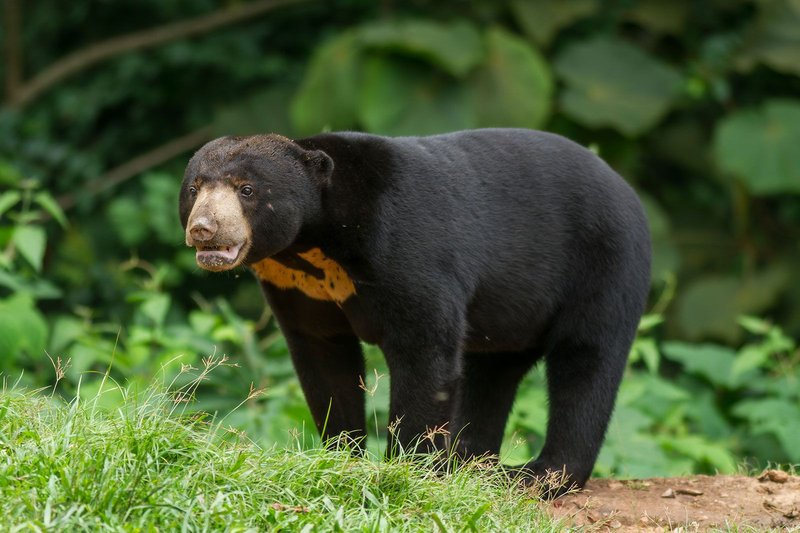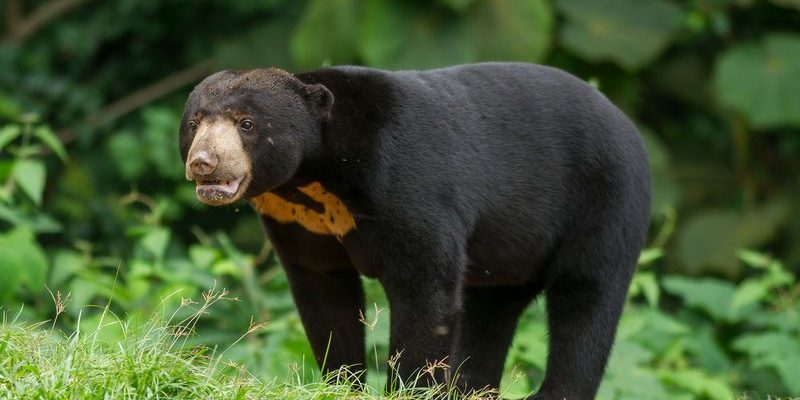
The Sun Bear, the smallest member of the bear family, is a fascinating creature that roams the tropical forests of Southeast Asia. Also known as the honey bear, these bears can easily capture your interest with their unique appearance and adorable demeanor. With their short legs, long tongues, and distinctive orange to cream-colored chest markings, they certainly stand out among the wildlife. Imagine a bear that looks like it’s been dipped in sunshine—this is the sun bear.
You might be wondering why they’re called sun bears. The name comes from the light-colored crescent moon or sun-shaped mark on their chest, which is reminiscent of sunlight filtering through trees. These little giants are not just about looks; they play a vital role in their ecosystem. By helping to spread seeds through their diet, they aid in maintaining the forest’s health. But there’s much more to these bears than their cute exterior, and in this article, we’ll explore their habitat, behavior, diet, and conservation status.
Physical Characteristics of the Sun Bear
Sun bears are fascinating not only for their size but for their unique physical traits. Adult sun bears typically weigh between 60 to 145 pounds and stand about 4 to 5 feet long. Their short, sleek fur is usually black, but with that striking patch of orange or cream on their chest, their appearance becomes both charming and memorable. Their small size compared to other bear species actually allows them to be quite agile, making them excellent climbers.
One of the most remarkable features of the sun bear is its long tongue, which can measure up to 10 inches! This long tongue aids them in reaching deep into tree trunks to extract honey and insects. You can picture them delicately licking honey from a beehive as if they were savoring a delicious treat. Additionally, their strong claws, which can be up to two inches long, help them dig and climb trees, further enhancing their survival in the wild.
You might notice that their large ears and small eyes give them a somewhat endearing, almost cartoonish look. But don’t be fooled by their cuteness; these bears are equipped with strong instincts. Their acute sense of smell helps them locate food sources, allowing them to thrive in their natural habitats. When you think of sun bears, picture a small yet mighty creature adapting perfectly to its environment.
Habitat and Range
Sun bears inhabit the tropical and subtropical forests of Southeast Asia, primarily found in countries like Malaysia, Thailand, Cambodia, and Indonesia. These bears prefer dense forests, where they can find plenty of food and cover for shelter. Being arboreal, they often climb trees, making their homes in the canopies to stay safe from larger predators.
Interestingly, the sun bear’s habitat is closely tied to the health of the rainforest ecosystem. They thrive in areas with abundant fruit trees and flowering plants, as these provide not only food but also the necessary conditions for their survival. Sun bears are also known to establish smaller territories, often overlapping with those of other bears, which allows them to share resources.
However, habitat loss due to deforestation poses a significant threat to their survival. As logging and agricultural expansion continue, sun bears find their natural habitats shrinking. This impacts their ability to find food and mates, putting their populations at risk. Conservation efforts aim to protect their habitats and raise awareness about the importance of preserving these unique creatures.
Diet and Feeding Behavior
When it comes to food, sun bears are primarily omnivorous, which means they enjoy a diverse diet. They are known to feast on fruits, insects, small animals, and honey—hence the nickname “honey bear.” Their long tongues are perfect for reaching deep into tree hollows to get to honeycomb. Can you imagine them delicately using that tongue to scoop out honey, just like we would with a spoon? It’s a sight to behold.
Additionally, sun bears play a critical role in maintaining their ecosystem by helping with seed dispersal. As they consume fruits and berries, they help spread seeds throughout the forest, promoting plant growth. This natural behavior contributes to forest regeneration, which is vital for the health of their environment. They are nature’s little gardeners, ensuring that the forest remains lush and vibrant.
Despite their ability to adapt to various food sources, sun bears often face challenges due to shrinking habitats. As their natural food sources become scarce, they may venture closer to human settlements in search of food, sometimes leading to conflicts. Educating communities about coexistence with sun bears is essential for their survival.
Behavior and Social Structure
Sun bears are generally solitary animals, although they are known to be social during mating season. Most of the time, they prefer to live alone, marking their territory with scent markings from glands in their paws. This helps them communicate and establish boundaries with other bears. You can think of it as their way of saying, “This is my space, please respect it!”
Even though they are solitary, sun bears are curious creatures. They spend a lot of time exploring their surroundings. Whether climbing trees or digging in the forest floor, they are always on the lookout for food or interesting sights. Their playful nature is often displayed as they play with natural elements in their habitat, showcasing their intelligent and inquisitive personalities.
When it comes to raising cubs, mother bears are very protective. After a gestation period of about 95 days, a mother sun bear usually gives birth to one or two cubs. These adorable little ones stay with their mother for up to two years, during which they learn vital survival skills. This nurturing bond helps them grow into independent bears capable of fending for themselves. It’s a tough world out there, and teaching young bears the ropes is essential.
Conservation Status and Threats
Despite their resilience, sun bears face numerous threats due to human activity. They are currently classified as vulnerable on the IUCN Red List. The primary threats to their survival include habitat destruction, poaching, and illegal wildlife trade. As forests are cleared for agriculture and logging, sun bears are losing their homes, and their populations are declining.
Additionally, sun bears are often hunted for their body parts, which are mistakenly believed to have medicinal properties in some cultures. This illegal trade poses a significant risk to their survival. Protecting these bears and their habitats is crucial for maintaining biodiversity and ecosystem health. Conservation efforts are underway in several regions, focusing on habitat preservation and creating protected areas for sun bears.
How can we help sun bears? Awareness is key. Supporting wildlife conservation organizations, advocating for responsible tourism, and spreading knowledge about the issues sun bears face can make a difference. Every action counts when it comes to preserving these beautiful creatures for future generations. Together, we can work towards ensuring that sun bears continue to thrive in their natural habitat.
Interesting Facts About Sun Bears
| Size: | 4 to 5 feet long |
| Weight: | 60 to 145 pounds |
| Lifespan: | Up to 25 years in the wild |
| Diet: | Omnivorous (fruits, insects, small animals) |
| Habitat: | Tropical forests of Southeast Asia |
| Social Structure: | Solitary, except during mating season |
FAQ
What does a sun bear eat?
Sun bears are omnivorous and have a diverse diet consisting of fruits, insects, and occasional small animals. They are famous for their love of honey, using their long tongues to extract it from beehives. When food is scarce in their environment, they adapt their diet according to what’s available, which is essential for their survival.
Where do sun bears live?
Sun bears primarily inhabit tropical and subtropical forests in Southeast Asia. Countries like Malaysia, Thailand, and Indonesia are key areas where these bears can be found. They prefer dense forest environments that provide ample food sources and shelter, making them integral to their ecosystem.
Are sun bears social animals?
Generally, sun bears are solitary creatures. However, they do come together during mating season to find partners. Outside of this time, they prefer to live alone, marking their territory to establish boundaries with other bears. Their solitary nature doesn’t mean they’re lonely; they thrive in their individual spaces.
How long do sun bears live?
In the wild, sun bears can live up to 25 years. Their lifespan can vary depending on factors like habitat quality, availability of food, and threats from humans or predators. In captivity, with proper care, they can live even longer due to protection from predators and consistent food supply.
Why are sun bears endangered?
Sun bears are classified as vulnerable primarily due to habitat loss, poaching, and illegal wildlife trade. As forests are cleared for agriculture and urban development, their natural environment shrinks, putting their populations at risk. Additionally, hunting for body parts used in traditional medicine exacerbates their endangerment.
What can we do to help sun bears?
Helping sun bears involves supporting conservation efforts, raising awareness about their plight, and advocating for responsible tourism. You can contribute by donating to wildlife organizations, participating in educational programs, and sharing information about sun bears to foster understanding and appreciation for these unique creatures.
Do sun bears play a role in their ecosystem?
Absolutely! Sun bears play a vital role in their ecosystem as seed dispersers. When they consume fruits and berries, they help propagate plant species throughout the forest. This natural behavior aids in maintaining the health and diversity of their environment, making them essential to their habitat’s ecological balance.
How do sun bears defend themselves?
Sun bears primarily rely on their agility and climbing ability to escape predators rather than direct confrontation. When threatened, they may climb trees or use their sharp claws to fend off attackers. Their keen sense of smell also helps them detect danger early, allowing them to evade threats effectively.
Are sun bears kept in zoos?
Yes, many zoos maintain sun bears in captivity as part of their conservation and education programs. These facilities often serve to educate the public about sun bears’ natural behaviors and conservation needs. Zoos also participate in breeding programs to help maintain a healthy population of sun bears.
How can I see a sun bear in the wild?
If you’re eager to see sun bears in their natural habitat, visiting wildlife reserves or protected areas in Southeast Asia during guided tours can provide such opportunities. Responsible tourism ensures minimal disturbance to their environment while allowing you to appreciate these incredible creatures. Just make sure to follow all regulations and guidelines to protect their habitat.

